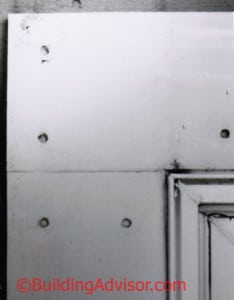Sally asks: What is the best way to flashing around a window? Is the flashing part of the window or the building exterior? Also, should there be a flashing above the window to divert water away?
Steve Bliss of BuildingAdvisor.com, responds: Water leakage around windows is one of the biggest problems in modern home construction, but you may not notice the problems until years later when hidden water damage shows up at stains, wood decay, or peeling paint (see photo). So careful installation by a skilled installer is critical here.

Most modern windows have a built-in flange along the top and sides of the window that are, to some extent, self-flashing. In some cases, the flange is installed in a groove by the installer but works the same way. You’ll find this type of flange on all vinyl and fiberglass windows as well as most windows with aluminum or vinyl cladding on the exterior.
The flange (either metal or plastic) goes under the siding and must be properly integrated with the housewrap to create a waterproof barrier. The flange is typically sealed in place with a strip of peel-and-stick flashing membrane or “flashing tape.” See typical window flashing installation details.
At the top of the window, an additional flashing called a “drip cap” should also be installed to help shed water, as you mentioned. The drip cap is typically aluminum or another non-corrosive metal, but can also be wood or plastic. It serves as an additional barrier to water and diverts it out away from the window and sill below. The specific details of installation depend on the trim and siding type around the window.
The most important point for window flashing, and all roof and wall flashing, is to lap upper layers of flashing materials over lower layers “shingle-style” so that water is directed to the exterior even if the adhesive membranes lose their grip over time. Even the best adhesive membranes cannot be relied on to seal forever. Also do not caulk any horizontal joints, as this will trap water that would otherwise drain to the exterior.
Read more on Window Flashing
Leave a Reply